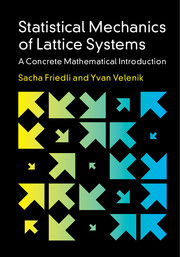Book contents
- Frontmatter
- Dedication
- Contents
- Preface
- Conventions
- 1 Introduction
- 2 The Curie–Weiss Model
- 3 The Ising Model
- 4 Liquid–Vapor Equilibrium
- 5 Cluster Expansion
- 6 Infinite-Volume Gibbs Measures
- 7 Pirogov–Sinai Theory
- 8 The Gaussian Free Field on Zd
- 9 Models with Continuous Symmetry
- 10 Reflection Positivity
- Appendix A Notes
- B Mathematical Appendices
- C Solutions to Exercises
- References
- Index
7 - Pirogov–Sinai Theory
Published online by Cambridge University Press: 17 November 2017
- Frontmatter
- Dedication
- Contents
- Preface
- Conventions
- 1 Introduction
- 2 The Curie–Weiss Model
- 3 The Ising Model
- 4 Liquid–Vapor Equilibrium
- 5 Cluster Expansion
- 6 Infinite-Volume Gibbs Measures
- 7 Pirogov–Sinai Theory
- 8 The Gaussian Free Field on Zd
- 9 Models with Continuous Symmetry
- 10 Reflection Positivity
- Appendix A Notes
- B Mathematical Appendices
- C Solutions to Exercises
- References
- Index
Summary
As we have already discussed several times in previous chapters, a central task of equilibrium statistical physics is to characterize all possible macroscopic behaviors of the system under consideration, given the values of the relevant thermodynamic parameters. This includes, in particular, the determination of the phase diagram of themodel. This can be tackled in at least two ways, as already seen in Chapter 3. In the first approach, one determines the set of all infinite-volume Gibbs measures as a function of the parameters of the model. In the second approach, one considers instead the associated pressure and studies its analytic properties as a function of its parameters; of particular interest is the determination of the set of values of the parameters at which the pressure fails to be differentiable.
Our goal in the present chapter is to introduce the reader to the Pirogov–Sinai theory, in which these two approaches can be implemented, at sufficiently low temperatures (or in other perturbative regimes), for a rather general class of models. This theory is one of the few frameworks in which first-order phase transitions can be established and phase diagrams constructed, under general assumptions.
To make the most out of this chapter, readers should preferably be familiar with the results derived for the Ising model in Chapter 3, as those provide useful intuition for the more complex problems addressed here. They should also be familiar with the cluster expansion technique described in Chapter 5, the latter being the basic tool we will use in our analysis. However, although it might help, a thorough understanding of the theory of Gibbs measures, as given in Chapter 6, is not required.
Conventions.We know from Corollary 6.41 that one-dimensional models with finite-range interactions do not exhibit phase transitions and thus possess a trivial phase diagram at all temperatures. We will therefore always assume, throughout the chapter, that d ≥ 2.
It will once more be convenient to adopt the physicists’ convention and let the inverse temperature β appear as a multiplicative constant in the Boltzmann weights and in the pressures. To lighten the notations, we will usually omit to mention β and the external fields, especially for partition functions.
Introduction
Most of Chapter 3 was devoted to the study of the phase diagram of the Ising model as a function of the inverse temperature β and magnetic field h.
- Type
- Chapter
- Information
- Statistical Mechanics of Lattice SystemsA Concrete Mathematical Introduction, pp. 346 - 408Publisher: Cambridge University PressPrint publication year: 2017



